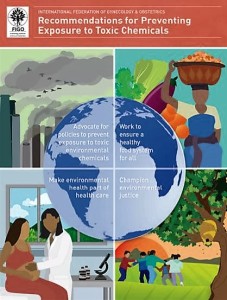Today a reader referred to the court orders against Pharmaceutical firm Johnson & Johnson (J&J) which has been ordered to pay more than $55m (£40m) in compensation to an American woman who said its talcum powder caused her ovarian cancer. In February, Johnson & Johnson paid $72m (£51m) in a similar case.
The International Federation of Gynecology and Obstetrics report brings to mind Jeremy Rifkin’s thoughts on ’primitive modern science’
The increasing use of hazardous chemicals in industry and agriculture with cumulative and long-term health impacts is a serious health threat. Even medically prescribed chemicals need more careful testing: many have done such unforeseen damage that they have been withdrawn or restricted to those who are not old, young, frail or pregnant.
 A 2015 report ( recommendations cover, left) by the London based International Federation of Gynecology and Obstetrics, covers the exposure to toxic environmental chemicals during pregnancy and breastfeeding.This brings to mind earlier findings including:
A 2015 report ( recommendations cover, left) by the London based International Federation of Gynecology and Obstetrics, covers the exposure to toxic environmental chemicals during pregnancy and breastfeeding.This brings to mind earlier findings including:
2002
Dana Mirick’s team at the Fred Hutchinson Cancer Research Center in Seattle undertook an epidemiological study, following widespread internet rumours that antiperspirant use causes breast cancer. Mirick found no evidence of any link. The research centre, described as independent, is funded by a US government department.
2004
The New Scientist in 2004 brought news of a US study by Dr Kris McGrath of Northwestern University published in the European Journal of Cancer Prevention (vol 12, p 479) suggested that deodorants or antiperspirants might be linked with breast cancer, but only together with underarm shaving. Northwestern ‘research’ University was founded by nine lawyers, businessmen and Methodist leaders to serve the people of the region and is governed by a board of trustees.
Mirick said that McGrath’s study has limitations – the most serious being the absence of a control group without breast cancer. Like Darbre [2004-2012], McGrath considers that the steady rise in the incidence of breast cancers could be linked to deodorants, but David Philips of the Institute of Cancer Research in London points out that the rise in underarm deodorant use seems to parallel or even lag slightly behind the cancer rise.
2007
In 2007 the EU’s ‘REACH’ directive came into force – calling for the Registration, Evaluation and Authorisation of Chemicals. This obliged manufacturers or importers to provide proof of the safety of thousands of hitherto chemicals in common use. The American chemical industry objected because the regulations threatened the export of more than $20bn worth of chemicals to Europe each year.
2008
In 2008 a healthy boy of 12 died of heart failure after spraying himself with too much deodorant, his inquest heard yesterday. He had inhaled too much Lynx Vice and the solvents in it caused an abnormal heartbeat. The Coroner, Dr Hunter, warned: “I do not know how many people read the warnings about exposure awareness. But people need to know about the risks that these products have on the cardio-vascular system.
2012
FIGO’s website carried an article reporting that research published in the Journal of Applied Toxicology Thursday, 12th January 2012 revealed that at least one paraben has been found in tissue samples from all participants of a study on the link between chemicals and breast cancer. All were found to have flesh containing at least one chemical which has been connected to underarm cosmetics.
Reader in oncology at the University of Reading, Dr Philippa Darbre, who led the study alongside Mr Lester Barr at the University Hospital of South Manchester, warned: “The fact that parabens were detected in the majority of the breast tissue samples cannot be taken to imply that they actually caused breast cancer in the 40 women studied.” Co-author Mr Lester Barr, said: ‘The intriguing discovery that parabens are present even in women who have never used underarm products raises the question: where have these chemicals come from?’
We note here that parabens are still widely used as a preservative in cosmetics, food products and pharmaceuticals.
Jeremy Rifkin, advisor to several governments, believes that modern science is too primitive to address the problems of a world at risk due to the scale and carelessness of human intervention. He calls for a new approach that prioritises the human and environmental health of the whole world
Recent Comments